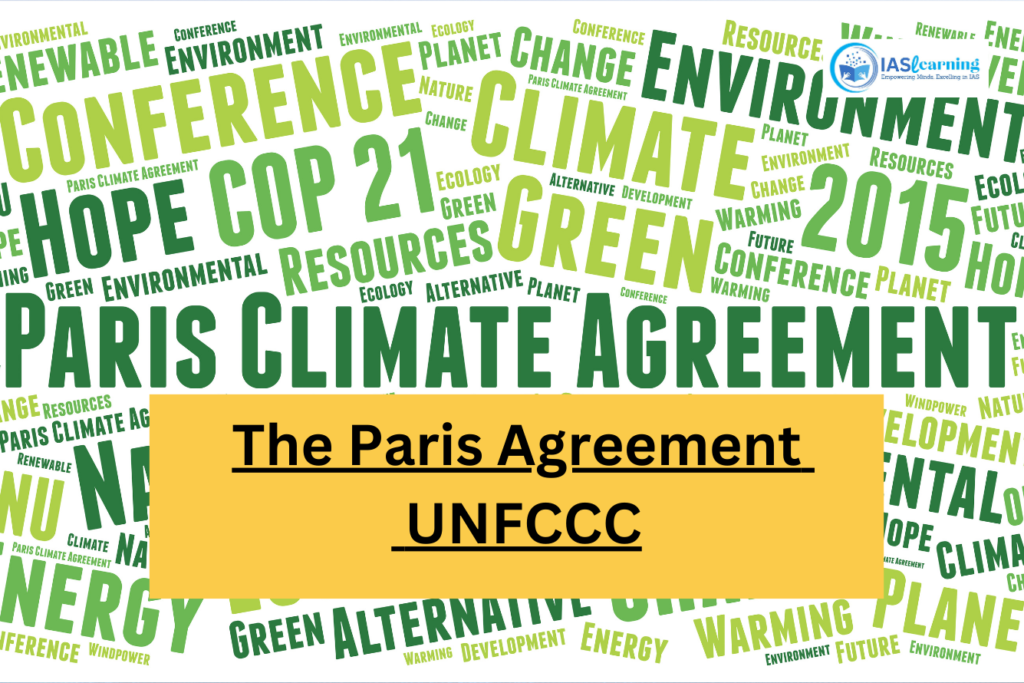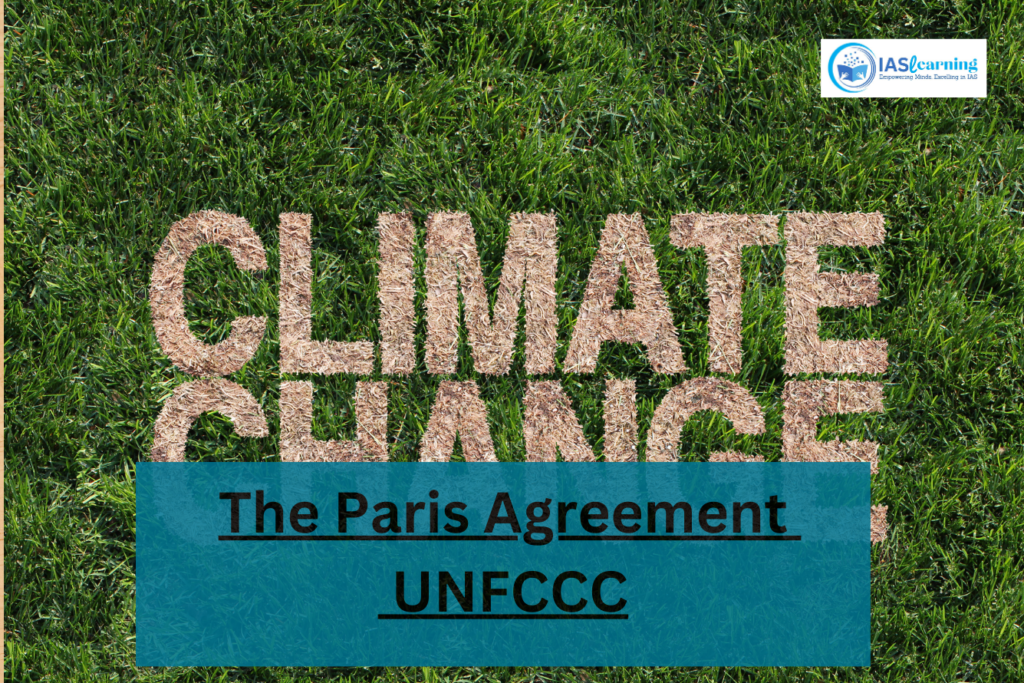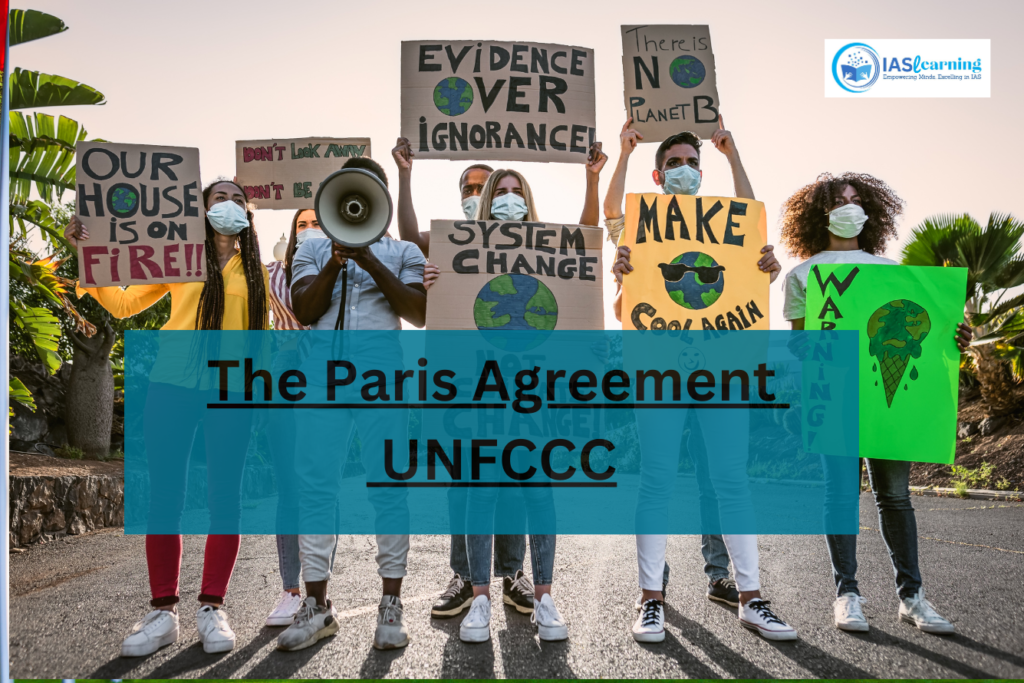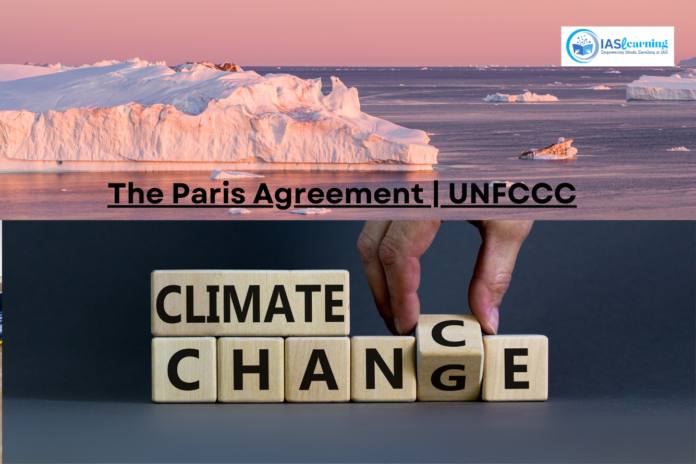What is the Paris Agreement?
The Paris Agreement, adopted at the UN Climate Change Conference (COP21) in 2015, is a legally binding treaty involving 196 Parties. It came into force on November 4, 2016, with the primary objective of curbing global temperature rise.
Objectives:
Global Temperature Targets: The primary goal is to limit the increase in the global average temperature:
- Below 2°C above pre-industrial levels.
- Pursue efforts to limit the increase to 1.5°C above pre-industrial levels.
Rationale for 1.5°C Target:

- Climate Change Impacts: Recent emphasis on limiting global warming to 1.5°C is driven by the UN’s Intergovernmental Panel on Climate Change (IPCC) warning:
- Crossing the 1.5°C threshold could result in more severe climate change impacts.
- Increased risks of frequent and severe droughts, heatwaves, and rainfall.
Critical Milestones for 1.5°C Goal:
- Emission Reductions: To achieve the 1.5°C target:
- Greenhouse gas emissions must peak before 2025.
- A 43% reduction by 2030 is crucial.
Significance of the Paris Agreement:
- Multilateral Collaboration: A landmark achievement in the multilateral climate change process.
- Binding Commitments: The first binding agreement bringing all nations together to combat climate change and adapt to its effects.
Challenges and Urgency:
- Global Cooperation: Necessity for sustained global cooperation to meet emission reduction targets.
- Timely Action: Urgent actions required to peak emissions before 2025 and achieve substantial reductions by 2030.
The Paris Agreement stands as a cornerstone in the global effort to address climate change, uniting nations in the shared responsibility of mitigating its impacts and securing a sustainable future.
How does the Paris Agreement work?

The implementation of the Paris Agreement demands a profound economic and social transformation grounded in the best available science. The agreement operates on a dynamic five-year cycle, emphasizing increasingly ambitious climate actions, known as ‘ratcheting up,’ undertaken by participating countries.
Key Components:
- Nationally Determined Contributions (NDCs):
- Countries submit national climate action plans (NDCs) since 2020.
- Each successive NDC aims for a higher level of ambition compared to its predecessor.
- Ambitious Climate Action:
- The five-year cycle encourages a continuous elevation of climate ambition globally.
- The intention is to limit global warming to 1.5°C above pre-industrial levels.
- COP27 Cover Decision:
- Recognizing the urgency for accelerated action, COP27 calls for a reassessment and enhancement of 2030 targets in NDCs.
- The objective is to align NDCs with the temperature goal of the Paris Agreement.
- Deadline for revisiting targets: End of 2023.
Objective:
- Temperature Goal Alignment: Ensure that revised NDCs, by the end of 2023, align with the Paris Agreement’s temperature goal of limiting global warming to 1.5°C.
Rationale:
- Urgency: Acknowledges the need for swift and enhanced actions to curb global warming.
- Different National Circumstances: Recognizes diverse national circumstances, requiring tailored approaches to climate action.
The evolving landscape of the Paris Agreement reflects a commitment to continuous improvement, urging nations to revisit and strengthen their climate targets, emphasizing the global imperative to address climate change with increased urgency and ambition.
Nationally Determined Contributions (NDCs)
Within their National Determined Contributions (NDCs), nations articulate strategies to fulfill the objectives of the Paris Agreement. These commitments encompass actions aimed at curbing greenhouse gas emissions to align with the agreement’s goals. Simultaneously, countries communicate measures to enhance resilience and adapt to the impacts of climate change.
Long-Term Strategies
Efforts toward the long-term goal within the Paris Agreement are enriched by the formulation and submission of Long-Term Low Greenhouse Gas Emission Development Strategies (LT-LEDS).
LT-LEDS extend the temporal scope of NDCs, offering a voluntary yet crucial dimension to countries’ climate commitments. Unlike NDCs, which are obligatory, LT-LEDS provide an expansive perspective, integrating climate objectives into the broader context of national long-term planning and development priorities.
These strategies contribute a visionary framework, aligning NDCs with countries’ future trajectories, thereby enhancing the coherence and effectiveness of global efforts to address climate change.
How are countries supporting one another?

The Paris Agreement establishes a framework for extending financial, technical, and capacity-building support to countries in need.
This framework reflects the commitment to fostering global collaboration and ensuring that nations receive the necessary assistance to effectively address climate change challenges. By providing a structured mechanism for financial aid, technological assistance, and capacity building, the Paris Agreement strives to facilitate a more inclusive and equitable approach to climate action, acknowledging the diverse needs and capacities of participating countries.
Finance
The Paris Agreement underscores the principle that developed countries bear the responsibility of leading in the provision of financial assistance to less endowed and more vulnerable nations. Notably, the agreement introduces a novel element by encouraging voluntary contributions from other Parties.
Climate finance plays a pivotal role in both mitigation and adaptation efforts. For mitigation, substantial investments are imperative to achieve significant emission reductions. Simultaneously, climate finance is equally crucial for adaptation, necessitating significant financial resources to effectively address and mitigate the adverse effects of a changing climate. The agreement thus emphasizes the dual importance of financial support in enabling nations to both reduce emissions and adapt to the impacts of climate change.
Technology
The Paris Agreement articulates a vision centered on the comprehensive achievement of technology development and transfer, serving the dual purpose of enhancing resilience to climate change and mitigating greenhouse gas (GHG) emissions. To guide the effective functioning of the Technology Mechanism, the agreement introduces a dedicated technology framework. This framework serves as a guiding structure for the Technology Mechanism, which, through its policy and implementation arms, actively accelerates technology development and facilitates the transfer of advanced solutions to address the challenges of climate change. The overarching goal is to foster innovation and collaboration in the pursuit of sustainable and impactful technological advancements.
Capacity-Building
Recognizing the varying capacities among developing countries to address the challenges posed by climate change, the Paris Agreement places significant emphasis on climate-related capacity-building initiatives. To bridge the gap, the agreement calls upon developed countries to strengthen their support for capacity-building actions in developing nations. This commitment underscores the importance of building the necessary skills, knowledge, and infrastructure in vulnerable regions, ensuring that all countries can effectively respond to the impacts of climate change. By prioritizing capacity-building, the Paris Agreement strives for a more inclusive and resilient global response to climate challenges.
How are we tracking progress?
The Paris Agreement introduces an Enhanced Transparency Framework (ETF), representing a significant step in promoting accountability and collective action. From 2024 onward, countries are mandated to transparently report on their climate change mitigation efforts, adaptation measures, and support given or received. The framework also incorporates international review procedures to ensure the accuracy and credibility of submitted reports.
The information compiled through the ETF serves as valuable input for the Global Stocktake, a comprehensive assessment of collective progress toward long-term climate goals. The findings of the Global Stocktake will, in turn, generate recommendations for countries to enhance their climate plans in subsequent rounds, fostering a cycle of continuous improvement and ambition within the global climate effort. The ETF establishes a robust mechanism for monitoring, reporting, and enhancing climate actions on an international scale.
What have we achieved so far?
Despite the imperative for a substantial increase in climate change action to meet the Paris Agreement goals, the years since its inception have witnessed the emergence of low-carbon solutions and burgeoning markets. A growing number of countries, regions, cities, and companies are setting carbon neutrality targets, catalyzing a transformative shift. Zero-carbon solutions have gained competitiveness across economic sectors, encompassing 25% of emissions, with the power and transport sectors notably leading this transition. This trend has not only sparked innovation but has also created lucrative business opportunities for early adopters.
Projections indicate that by 2030, zero-carbon solutions could vie for competitiveness in sectors representing over 70% of global emissions, signifying a substantial potential for further transformative change and progress. The momentum generated since the inception of the Paris Agreement underscores the promising trajectory toward a low-carbon future.




